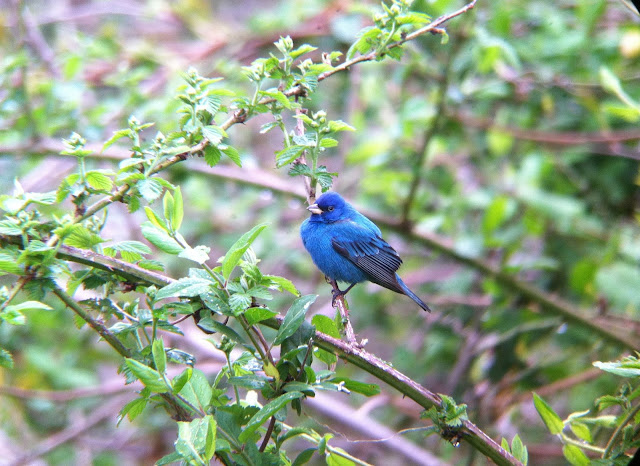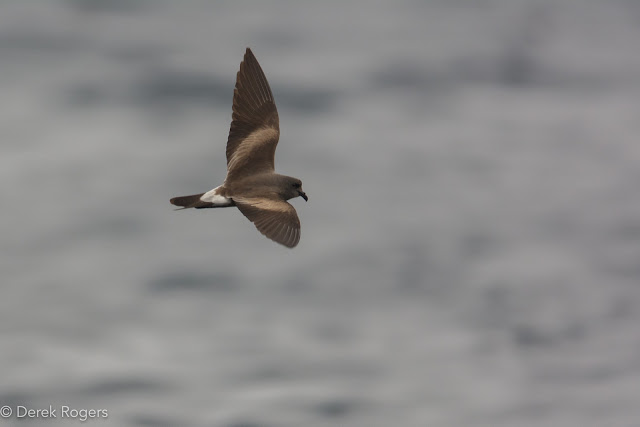The fun began on Sunday, April 22nd when 2 Indigo Buntings were feeding on dandelion seeds directly in front of my doorstep. Indigo Buntings are an attractive looking bird. As the name suggests, Indigo Bunting males are bright blue. It's a color that one simply cannot recreate. Other than the visual feast that the indigos provided, it was exciting to log this species into the property list, at bird species # 147. I am actually surprised that it has taken 6 years to see an Indigo Bunting. You always wonder, what will be next? Indigo Buntings are a fairly widespread species holding a large range within North America. They breed throughout NY State but more sparsely throughout mountainous territory. Indigos like brushy open habitats with edges and trees nearby.
 |
| Indigo Bunting photo by Derek Rogers |
The recent migration push, coupled with last weekends coastal low pressure system that moved up the coast, ended up delivering some displaced birds along the barrier beaches. Among these birds were the grosbeaks and buntings. In the past week, good numbers of these birds have been reported from western Long Islands coastal sites. Anxious to see some of these beauty's, I took a couple evening barrier beach runs to try and find some these birds myself. After hearing about several Indigo Buntings being spotted at Gilgo Beach, I decided that it might be a good idea to search that area for other species that may be accompanying them. It was on 4/24/2012 that I found my first "Long Island" Blue Grosbeak. It was a bright, handsome male that was foraging on the ground along south side of the main parking area at Gilgo Beach. Blue Grosbeak like large, open brushy fields. They usually forage hidden, low in the weeds for insects and seeds. Blue Grosbeak have a widespread range in North America but are not a common breeder in New York State. The 2000-05 NYS Breeding Bird Atlas shows only 1 confirmed breeding block in the entire state with only a couple of hand fulls of possible/probable breeding blocks. Blue Grosbeak is a species that seems to be slowly increasing it's population. The species also continues to show a northward range expansion. Perhaps New York will one day become a strong hold for breeding Blue Grosbeak. I hope so.
 |
Blue Grosbeak photo by Derek Rogers
|
Yesterday evening, I decided it would be nice to see a Rose-breasted Grosbeak. Knowing that this week would be as good a bet as any to find Rose-Breasted Grosbeak on the barrier beaches I set off for another evening session out to the barrier beaches. I started at Gilgo again in hopes to see the beautiful Blue Grosbeak. It was not showing but as a consolation prize I found my FOS (First of Season) Red-Eyed Vireo. This was exciting but I still wanted my Rose-breasted. I decided to drive the roadways and field edges at Robert Moses State Park. Well a little bit of combination of luck and perseverance had paid off because I found a Rose-Breasted Grosbeak. Like the two aforementioned species, this bird is also a real beauty. The individual that I found was a going onto it's very first year of becoming a breeding individual. This was apparent in its plumage as you could still see hints of it's 1st winter plumage tertials and primary's. What an exciting bird. Check my Flickr photostream to see some video footage of the Rose-breasted Grosbeak foraging on the ground at Robert Moses.
 |
| Rose-Breasted Grosbeak photo by Derek Rogers |






Great recount, enjoying your stuff. It's been a long time since I was back at Long Island. You really bring out the best side of her!
ReplyDelete